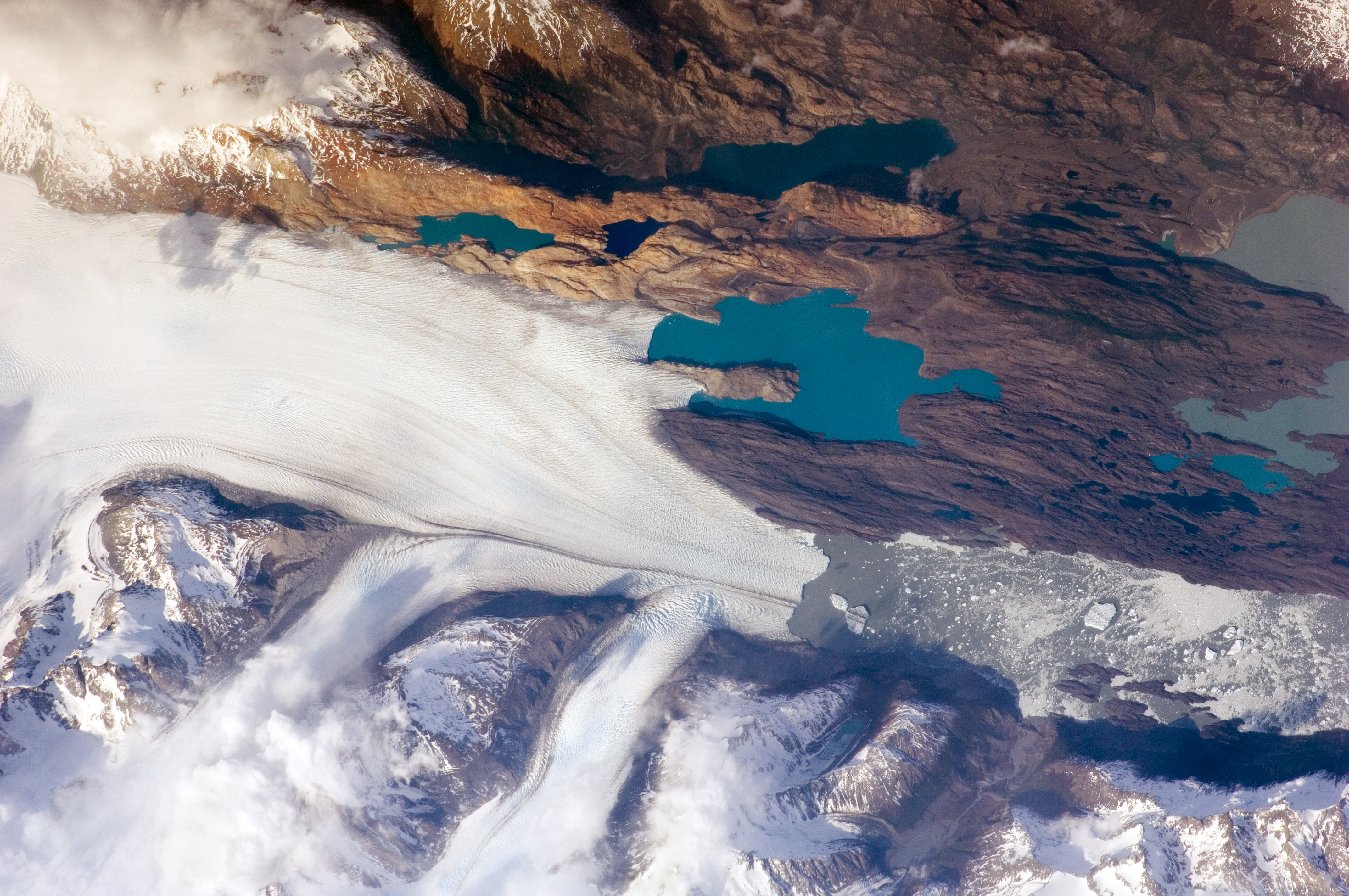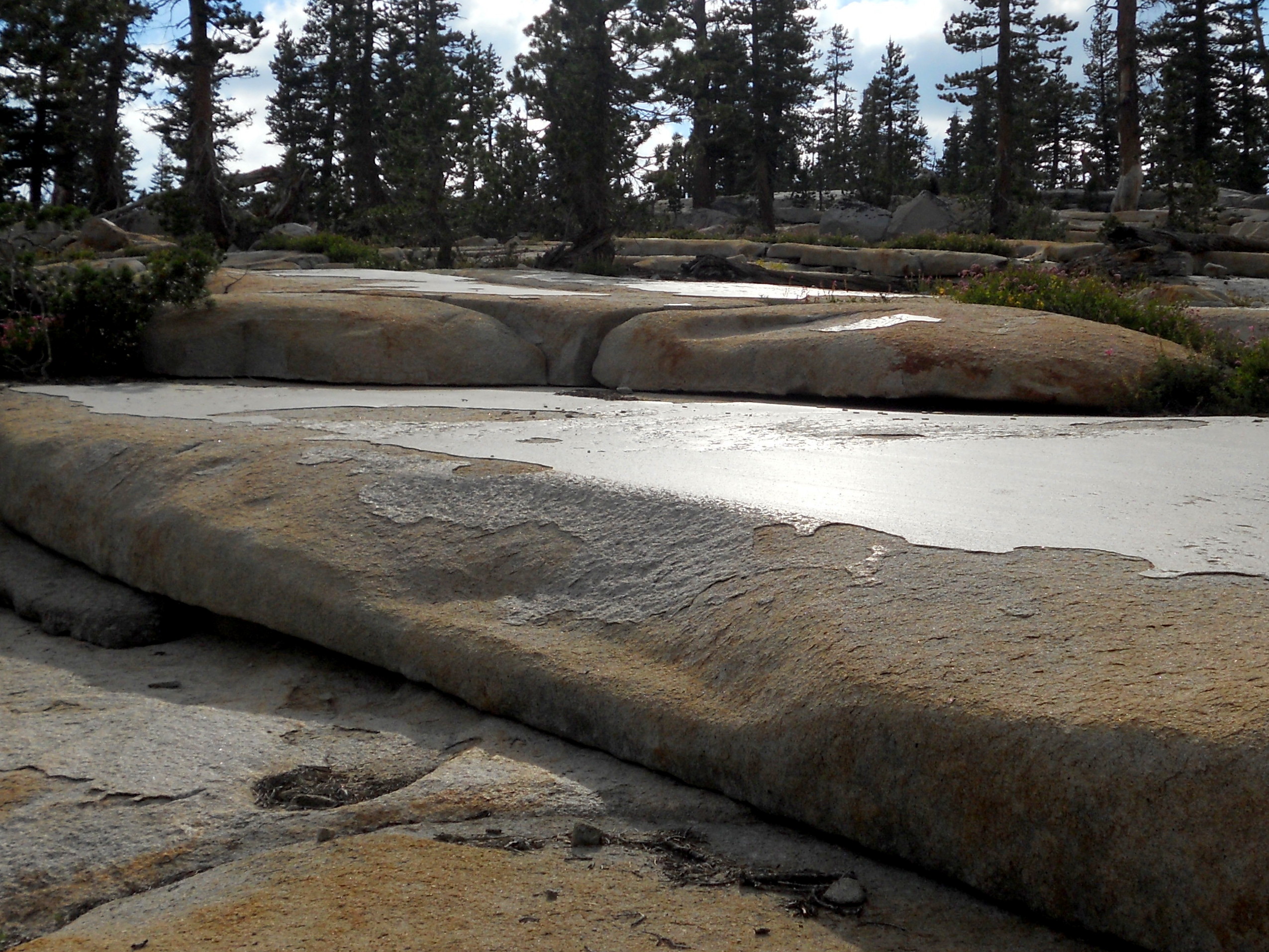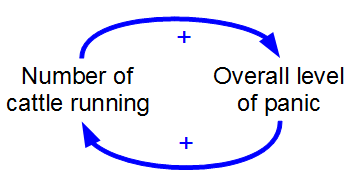|
Plucking (glaciation)
Plucking, also referred to as ''quarrying'', is a glacial phenomenon that is responsible for the weathering and erosion of pieces of bedrock, especially large "joint blocks". This occurs in a type of glacier called a "valley glacier". As a glacier moves down a valley, friction causes the basal ice of the glacier to melt and infiltrate joints (cracks) in the bedrock. The freezing and thawing action of the ice enlarges, widens, or causes further cracks in the bedrock as it changes volume across the ice/water phase transition (a form of hydraulic wedging), gradually loosening the rock between the joints. This produces large pieces of rock called joint blocks. Eventually these joint blocks come loose and become trapped in the glacier. In this way, plucking has been linked to regelation. Rocks of all sizes can become trapped in the bottom of the glacier. Joint blocks up to three meters have been "plucked" and transported. These entrained rock fragments can also cause abrasion along ... [...More Info...] [...Related Items...] OR: [Wikipedia] [Google] [Baidu] |
Glacial Tarn Formation EN
A glacial period (alternatively glacial or glaciation) is an interval of time (thousands of years) within an ice age that is marked by colder temperatures and glacier advances. Interglacials, on the other hand, are periods of warmer climate between glacial periods. The Last Glacial Period ended about 15,000 years ago. The Holocene is the current interglacial. A time with no glaciers on Earth is considered a Greenhouse and icehouse Earth, greenhouse climate state. Quaternary Period Within the Quaternary, which started about 2.6 million years before present, there have been a number of glacials and interglacials. At least eight glacial cycles have occurred in the last 740,000 years alone. Penultimate Glacial Period The Penultimate Glacial Period (PGP) is the glacial period that occurred before the Last Glacial Period. It began about 194,000 years ago and ended 135,000 years ago, with the beginning of the Eemian interglacial. Last Glacial Period The last glacial period was the m ... [...More Info...] [...Related Items...] OR: [Wikipedia] [Google] [Baidu] |
Frost Weathering
Frost weathering is a collective term for several mechanical weathering processes induced by stresses created by the freezing of water into ice. The term serves as an umbrella term for a variety of processes such as frost shattering, frost wedging and cryofracturing. The process may act on a wide range of spatial and temporal scales, from minutes to years and from dislodging mineral grains to fracturing boulders. It is most pronounced in high-altitude and high-latitude areas and is especially associated with alpine, periglacial, subpolar maritime and polar climates, but may occur anywhere at sub-freezing temperatures (between -3 and -8 °C) if water is present. Ice segregation Certain frost-susceptible soils expand or heave upon freezing as a result of water migrating via capillary action to grow ice lenses near the freezing front. This same phenomenon occurs within pore spaces of rocks. The ice accumulations grow larger as they attract liquid water from the surrounding ... [...More Info...] [...Related Items...] OR: [Wikipedia] [Google] [Baidu] |
Drumlin Field
A drumlin, from the Irish word ''droimnín'' ("littlest ridge"), first recorded in 1833, in the classical sense is an elongated hill in the shape of an inverted spoon or half-buried egg formed by glacial ice acting on underlying unconsolidated till or ground moraine. Assemblages of drumlins are referred to as fields or swarms; they can create a landscape which is often described as having a 'basket of eggs topography'. The low ground between two drumlins is known as a dungeon; dungeons have colder microclimates in winter from settling cold air. Morphology Drumlins occur in various shapes and sizes, including symmetrical (about the long axis), spindle, parabolic forms, and transverse asymmetrical forms. Generally, they are elongated, oval-shaped hills, with a long axis parallel to the orientation of ice flow and with an up-ice (stoss) face that is generally steeper than the down-ice (lee) face. Drumlins are typically 250 to 1,000 meters long and between 120 and 300 meters wide ... [...More Info...] [...Related Items...] OR: [Wikipedia] [Google] [Baidu] |
Glacial Erratic
A glacial erratic is glacially deposited rock differing from the type of rock native to the area in which it rests. Erratics, which take their name from the Latin word ' ("to wander"), are carried by glacial ice, often over distances of hundreds of kilometres. Erratics can range in size from pebbles to large boulders such as Big Rock () in Alberta. Geologists identify erratics by studying the rocks surrounding the position of the erratic and the composition of the erratic itself. Erratics are significant because: *They can be transported by glaciers, and they are thereby one of a series of indicators which mark the path of prehistoric glacier movement. Their lithographic origin can be traced to the parent bedrock, allowing for confirmation of the ice flow route. *They can be transported by ice rafting. This allows quantification of the extent of glacial flooding resulting from ice dam failure which release the waters stored in proglacial lakes such as Lake Missoula. Erratics ... [...More Info...] [...Related Items...] OR: [Wikipedia] [Google] [Baidu] |
Roche Moutonnée
In glaciology, a roche moutonnée (or sheepback) is a rock formation created by the passing of a glacier. The passage of glacial ice over underlying bedrock often results in asymmetric erosional forms as a result of abrasion on the "stoss" (upstream) side of the rock and plucking on the "lee" (downstream) side. These erosional features are seen on scales of less than a metre to several hundred metres.Douglas Benn and David Evans, ''Glaciers & Glaciation,'' Arnold, London, 1st ed. 1998 Etymology The 18th-century Alpine explorer Horace-Bénédict de Saussure coined the term ''Roches moutonnées'' in 1786. He saw in these rocks a resemblance to the wigs that were fashionable amongst French gentry in his era and which were smoothed over with mutton fat (hence ''moutonnée'') so as to keep the hair in place. The French term is often incorrectly interpreted as meaning "sheep rock". Description The contrasting appearance of the erosional stoss and lee aspects is very defined on r ... [...More Info...] [...Related Items...] OR: [Wikipedia] [Google] [Baidu] |
Moraine
A moraine is any accumulation of unconsolidated debris (regolith and rock), sometimes referred to as glacial till, that occurs in both currently and formerly glaciated regions, and that has been previously carried along by a glacier or ice sheet. It may consist of partly rounded particles ranging in size from boulders (in which case it is often referred to as boulder clay) down to gravel and sand, in a groundmass of finely-divided clayey material sometimes called glacial flour. Lateral moraines are those formed at the side of the ice flow, and terminal moraines were formed at the foot, marking the maximum advance of the glacier. Other types of moraine include ground moraines (till-covered areas forming sheets on flat or irregular topography) and medial moraines (moraines formed where two glaciers meet). Etymology The word ''moraine'' is borrowed from French , which in turn is derived from the Savoyard Italian ("mound of earth"). ''Morena'' in this case was derived from Proven� ... [...More Info...] [...Related Items...] OR: [Wikipedia] [Google] [Baidu] |
Till
image:Geschiebemergel.JPG, Closeup of glacial till. Note that the larger grains (pebbles and gravel) in the till are completely surrounded by the matrix of finer material (silt and sand), and this characteristic, known as ''matrix support'', is diagnostic of till. image:Glacial till exposed in roadcut-750px.jpg, Glacial till with tufts of grass Till or glacial till is unsorted glacier, glacial sediment. Till is derived from the erosion and entrainment of material by the moving ice of a glacier. It is deposited some distance down-ice to form terminal, lateral, medial and ground moraines. Till is classified into primary deposits, laid down directly by glaciers, and secondary deposits, reworked by fluvial transport and other processes. Description Till is a form of '' glacial drift'', which is rock material transported by a glacier and deposited directly from the ice or from running water emerging from the ice. It is distinguished from other forms of drift in that it is depos ... [...More Info...] [...Related Items...] OR: [Wikipedia] [Google] [Baidu] |
Glacial Striation
Glacial striations or striae are scratches or gouges cut into bedrock by glacial abrasion. These scratches and gouges were first recognized as the result of a moving glacier in the late 18th century when Swiss alpinists first associated them with moving glaciers. They also noted that if they were visible today that the glaciers must also be receding. Glacial striations are usually multiple, straight, and parallel, representing the movement of the glacier using rock fragments and sand grains, embedded in the base of the glacier, as cutting tools. Large amounts of coarse gravel and boulders carried along underneath the glacier provide the abrasive power to cut trough-like ''glacial grooves''. Finer sediments also in the base of the moving glacier further scour and polish the bedrock surface, forming a ''glacial pavement''. Ice itself is not a hard enough material to change the shape of rock but because the ice has rock embedded in the basal surface it can effectively abrade the b ... [...More Info...] [...Related Items...] OR: [Wikipedia] [Google] [Baidu] |
Glacial Polish
Glacial polish is a characteristic of rock surfaces where glaciers have passed over bedrock, typically granite or other hard igneous or metamorphic rock. Moving ice will carry pebbles and sand grains removed from upper levels which in turn grind a smooth or grooved surface upon the underlying rock. The presence of such polish indicates that the glaciation was relatively recent (in geologic time scale) or was subsequently protected by deposition, as such polish will be subsequently lost due to weathering processes (such as exfoliation). See also *Glacial striation Glacial striations or striae are scratches or gouges cut into bedrock by glacial abrasion. These scratches and gouges were first recognized as the result of a moving glacier in the late 18th century when Swiss alpinists first associated them w ... References Glaciology {{glaciology-stub ... [...More Info...] [...Related Items...] OR: [Wikipedia] [Google] [Baidu] |
Striation (geology)
In geology, a striation is a groove, created by a geological process, on the surface of a rock or a mineral. In structural geology, striations are linear furrows, or linear marks, generated from fault movement. The striation's direction reveals the movement direction in the fault plane. Similar striations, called glacial striations, can occur in areas subjected to glaciation. Striations can also be caused by underwater landslides. Striations can also be a growth pattern or mineral habit that looks like a set of hairline grooves, seen on crystal faces of certain minerals. Examples of minerals that can show growth striations include pyrite, feldspar, quartz, tourmaline, chalcocite and sphalerite. Glacial Striations The surface of rocks can have an altered appearance as a result of the movement of ice. They can show a polished looking surface scarred with glacial striations. Often these striations carved into the bedrock extend for long distances. The scars are a result of ... [...More Info...] [...Related Items...] OR: [Wikipedia] [Google] [Baidu] |
Positive Feedback
Positive feedback (exacerbating feedback, self-reinforcing feedback) is a process that occurs in a feedback loop which exacerbates the effects of a small disturbance. That is, the effects of a perturbation on a system include an increase in the magnitude of the perturbation. That is, ''A produces more of B which in turn produces more of A''.Keesing, R.M. (1981). Cultural anthropology: A contemporary perspective (2nd ed.) p.149. Sydney: Holt, Rinehard & Winston, Inc. In contrast, a system in which the results of a change act to reduce or counteract it has negative feedback. Both concepts play an important role in science and engineering, including biology, chemistry, and cybernetics. Mathematically, positive feedback is defined as a positive loop gain around a closed loop of cause and effect. That is, positive feedback is Phase (waves), in phase with the input, in the sense that it adds to make the input larger. Positive feedback tends to cause Control theory#Stability, system i ... [...More Info...] [...Related Items...] OR: [Wikipedia] [Google] [Baidu] |
Clastic Rock
Clastic rocks are composed of fragments, or clasts, of pre-existing minerals and rock. A clast is a fragment of geological detritus,Essentials of Geology, 3rd Ed, Stephen Marshak, p. G-3 chunks, and smaller grains of rock broken off other rocks by physical weathering.Essentials of Geology, 3rd Ed, Stephen Marshak, p. G-5 Geologists use the term clastic to refer to sedimentary rocks and particles in sediment transport, whether in suspension or as bed load, and in sediment deposits. Sedimentary clastic rocks Clastic sedimentary rocks are rocks composed predominantly of broken pieces or ''clasts'' of older weathered and eroded rocks. Clastic sediments or sedimentary rocks are classified based on grain size, clast and cementing material (matrix) composition, and texture. The classification factors are often useful in determining a sample's environment of deposition. An example of clastic environment would be a river system in which the full range of grains being transported by ... [...More Info...] [...Related Items...] OR: [Wikipedia] [Google] [Baidu] |





